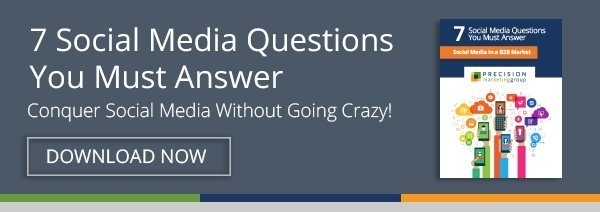With over 2.41 billion people actively using Facebook on a monthly basis, you might be thinking it's an absolute no-brainer to leverage Facebook for your business. But what gives? Why isn't your page ALIIIIIIIIIIIIIVE yet?! If you're having trouble getting value out of your Facebook marketing strategy, you might be making some monster mistakes that are messing with your results. *Cue the howling wolf*
So what can you do to fix up your Facebook presence? Unfortunately, we're all out of our magic potions and witch's brew. BUT we can offer up these 15 tips that will help raise your business page from the dead. Follow these steps and you'll see your social media ROI increase faster than you can say Trick-or-Treat!
1. Skipping over establishing goals.
Before you dive right into Facebook marketing, you need to set some strategic objectives. What do you want to get out of Facebook for your business? More traffic to your website? Conversions? Market research? Conversation and engagement with your audience? You can't measure the success of your strategy without first creating goals to work towards—and then deciding on the metrics that will be used to determine whether or not you achieve them. Just be sure to keep expectations realistic for your company and your industry.
2. Misinterpreting how your audience uses Facebook.
The average American adult spends 43 minutes per day on Facebook! If your business can muster up a decent following, that provides a lot of potential for getting eyes on your content. However, keep in mind that Facebook is the epitome of a social network. Most people use it primarily for social reasons, and they aren't actively using it to conduct research for work. LinkedIn and Twitter are much more business-oriented—particularly for B2B professionals, so if Facebook isn't right for your company, then we recommend not putting too much time into this platform.
However, Facebook is an easy way for a prospect to subscribe to your content once they discover something they like on your website, giving them convenient access to updates and other gems you might be posting. What's more, most users actually expect a company to have a presence on FB (Social Media Examiner reports that 95% of Millennials and 87% of Gen X'ers expect brands to have a Facebook page.) That said, only commit to developing one if you're willing and able to post consistently.
3. Posting at random.
Again, be consistent. Don't push out lots of content all at once and then leave your audience hanging for the rest of the month. Set aside time on a weekly basis to map out what you'd like to share with your audience throughout the next few days. Then use tools like HubSpot or HootSuite to coordinate all of your social posts and schedule them in advance. That way, you don't have to constantly keep Facebook open in your browser or spend time updating your page every day.
4. Letting comments and messages slip through the cracks.
If someone comments on one of your posts, it's important that someone on your team responds within 24 hours. After all, social media is all about engaging with your fans and followers. Moreover, Facebook's Messenger app is intended to make conversations feel more natural, so don't forget to keep tabs on questions from prospects or customers in your Facebook inbox. We also generally recommend not to delete comments (unless there is a very specific reason), even if they're in poor taste or highly critical. This reduces the credibility of your business and sends a message that you aren't open to hearing negative feedback.
5. Using a personal profile in lieu of a page.
First off, this is a violation of Facebook’s Terms of Use—Facebook clearly states you're not allowed to use a personal profile as a business page. Many SMB owners and marketers starting out with social media aren't always aware of this, so if you're guilty of this particular mistake, you should convert your page to the right format ASAP.
With that said, Facebook business pages also have numerous many benefits associated with them. As opposed to operating with a normal profile, your connections are no longer limited to 5,000 friends. There are so many marketing-specific features—including ads, apps and analytics—that are exclusively for Facebook pages. And… now here's a helpful feature… you can implement a Call-to-Action button that appears beneath your cover photo. There are a variety of options, including Sign Up, Contact Us, Book Now, Shop Now, See Offers etc., and you can link this button to any corresponding landing page on your website.
6. Avoiding the sharing of third-party content.
Yes, Facebook is a great place to promote your blog posts, resources and press releases. But overly promotional posts are annoying. SO annoying. So don't forget to mix in some interesting third-party articles on topics that matter to your audience—and share content directly from other business pages. Have some cool clients? Share one of their stories! Remember, once again, a Facebook marketing strategy is about being social. It's not all about you.
7. Losing track of your brand.
Since Facebook is relatively image-centric, you really want to make sure your brand's story, personality and values come across in the messaging—and that includes your choices in photos and videos. However, most of that responsibility falls on the content you're posting, so make sure what you're publishing is reflective of who you are, what your company does for its buyers, and what your company aspires to be. Moreover, keep your brand's design (logo, colors, writing style, etc.) consistent with your website's aesthetic. Your Facebook page should be an extension of your business, not an entirely separate entity.
8. Bypassing Facebook Live
Back in April 2016, Facebook launched Facebook Live, a real-time video streaming service that lets users broadcast from their mobile devices straight to their Facebook News Feed. Vimeo reports that 78% of online audiences are watching video on Facebook Live, so its popularity should not be overlooked!
What you may not know is that broadcasters can decide who on Facebook can see their video and specifically use this content to engage and entice relevant audiences during the situations and events that matter to them. While broadcasting, just be sure to interact with your viewers (you'll be able to see their comments showing up on the bottom of your feed). Facebook Live provides so much opportunity to generate excitement about your B2B business, and to showcase your company culture. If you're interested in learning more, HubSpot published this helpful guide to effectively using Facebook Live—feel free to check it out!
9. Sharing posts that are too long.
If you search for stats on the ideal Facebook post length, you'll find a number of results. But what do pretty much all of them emphasize? Brevity. Keep your posts short and sweet. Or you might be seeing your click-through rate plummet.
10. Leaving the 'About' sections blank.
The Short Description, the Long Description, the Mission, the Company Overview—some of these sections may seem a little repetitive. But if you fluidly weave each piece together, it's an easy way to get the story of your brand across to the audience. So don't squander that opportunity by leaving sections blank! Come up with a creative way to highlight different aspects of your business—and utilize the Awards section if applicable, as it's the perfect chance for you to shamelessly brag about your success!
11. Using generic templates and tabs.
On a related note to #10, Facebook allows you to select a business page template that works for your particular company and industry, and you can also populate the 'Tabs' on the left side of the page with custom options. For example, because PMG is a marketing agency that offers professional services, we've selected to use the Services template. However, we've turned off the "Default Tabs" switch and opted to pick out which Tabs best showcase our business best. If your company offers special services to customers, let them know! The Services tab is a great way to promote what you do without appearing overly sales-y.
12. Ignoring cover photo dimensions.
There's almost nothing worse on Facebook than a cover photo that doesn't fit the frame. It just screams unprofessional. If you cut off your logo or a part of your image and you can't seem to get it cropped right, don't just give up. First, ensure your cover photo is 820 pixels wide and 312 pixels tall. If you upload a smaller image, Facebook will stretch it until it fits, and this might look even worse. Also note that to avoid compression when you upload your cover photo, the file size must be smaller than 100KB.
13. Failing to drive fans back to your website.
Particularly if you are using Facebook to generate traffic and leads, obviously you need to have the Website section filled out—but you also can write links into other sections. For example, here's what PMG has placed at the bottom of our Products section:
You never know who will find it and click! More importantly, make sure you're using Facebook to promote your blog posts and offers. The bulk of your content should be educational / helpful (and yes, I know I said not to overly promote yourself), but balance out your publishing calendar with some resources you offer on your own website—tip sheets, eBooks, on-demand webinars—whatever content you've produced that is still helpful to your fan base.
14. Not engaging with other business pages.
Okay B2B marketers, this is particularly important for you! Set aside time to find pages managed by companies and thought leaders in your niche or industry, 'like' those pages, and then interact with them! Comment on content. Ask questions in relevant groups and communities to engage others and create awareness of your own page. Don't be shy! Show people that you have something valuable to offer.
15. Overlooking analytics.
Oh, the power of data. If you aren't using an integrated marketing platform to measure your progress, you can at least use Facebook Insights. It's actually pretty cool! Insights helps you understand the demographic breakdown of your audience, as well as which content (and writing style) is resonating with your fans and driving the most engagement. Use this information to strategically plan future posts.
See? It doesn't take a séance to breathe life into your Facebook business page. Just heed this advice and you'll see a difference in no time.
Have more social media marketing questions? Feel free to leave them in the comments section below or contact us directly. We're always glad to help. For now, go dig into that giant bowl of candy and have a Happy Halloween!! 👻🎃🍭🍬🔮





